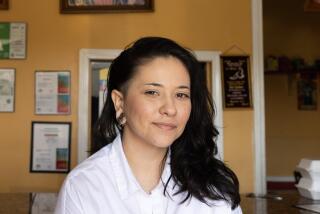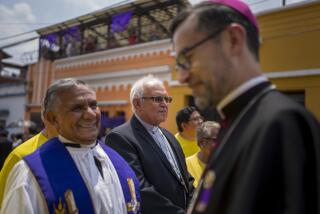Evangelists Threaten Mayan Traditions : Religion: Protestant fundamentalists are opposed to Catholic missionaries’ practice of blending rituals to convert the Guatemalan natives.
- Share via
GUATEMALA CITY — Indians cross themselves like Roman Catholics on the steps of Santo Tomas, a 16th-Century church in Guatemala’s southwestern highlands, then burn cheap rum and speak to Mayan gods.
Inside the whitewashed church in the town of Chichicastenango, copal incense burns before a Catholic altar. Sand and feather designs are laid out to honor a departed relative in the Mayan way.
Chickens are sacrificed in the church, black ones for the sick, red for good luck.
Half of the 9 million people in Guatemala are Indians, and most cannot read or write. Their religion is an amalgam of centuries-old pagan beliefs and Catholic ritual.
As Catholics and the growing Protestant evangelical movement convert the Maya, however, the traditional Indian way of life gradually fades.
In recent years, some Catholic missionaries have encouraged the blend of rituals in their effort to convert the Indians, who speak 22 separate languages.
Until missionaries became active in the highlands in the 1950s, most Indians did not realize that their form of Catholicism differed from the orthodox. As they are taught the differences, they continue mixing Christian rituals with native ones that include offering rum and cigars to such Indian saints as Maximon, a combination wise man, healer and judge.
“There is some confusion between Mayan rituals and the Catholic faith, but we just have to try harder to explain our faith so they will understand,” said Father Erwin Garcia, secretary to the archbishop of Guatemala.
He said some priests had gone to extraordinary lengths to reach the Indians: The bishop of the Peten region in northern Guatemala, for instance, takes part in Indian-Catholic ceremonies such as dancing around a rock altar inside a circle of pine needles.
Indians make up more than 30% of Catholic seminary students in Guatemala, and 35 have been ordained since 1950, Garcia said.
Protestant evangelicals do not share the tolerance for traditional Mayan beliefs.
“We’re trying to stop the rituals,” said Edmundo Madrid, president of the Evangelical Alliance. “The Indians do all kinds of image worshiping and believe in animism. They put eggs on peoples’ stomachs to cure them and a glass of water under the bed to catch evil spirits. They give liquor as an offering, and we are totally against alcohol.
“The Catholics go along with this, but we preach against it.”
Madrid said his organization of more than 700 evangelical congregations in Guatemala City plans to investigate the Mayan Academy recently established by Congress to preserve the Indian heritage.
“They are committed to keeping Mayan culture alive, but that culture is full of practices that are not right,” he said.
For centuries, the Indian civil-religious hierarchy has been organized into cofradias , or ritual brotherhoods. They perform civic duties and organize elaborate fiestas that are the major form of public worship.
Cofradias are vanishing as Protestants and Catholics draw converts from their ranks. Some violence has occurred between missionaries and traditional believers over access to local churches and celebrating the feast days of a town’s patron saints.
“This decade will be the last of ethnic diversity in Guatemala,” predicted Samuel Franco, who has studied the Indians since 1984.
“In the last 10 years, the Catholics and all the new fundamentalist groups here have bombarded the Indians and have done their best to change their way of life,” he said.
Protestant fundamentalism gained influence in Guatemala after an earthquake in 1976, when thousands of evangelical missionaries arrived with aid. Many stayed to proselytize, and about 35% of Guatemalans now are evangelical Protestants.
Both Catholic and evangelical clergy are working on translations of the Bible into Mam, Quiche and Cakchiquel, the three principal Mayan languages.
More to Read
Sign up for Essential California
The most important California stories and recommendations in your inbox every morning.
You may occasionally receive promotional content from the Los Angeles Times.









